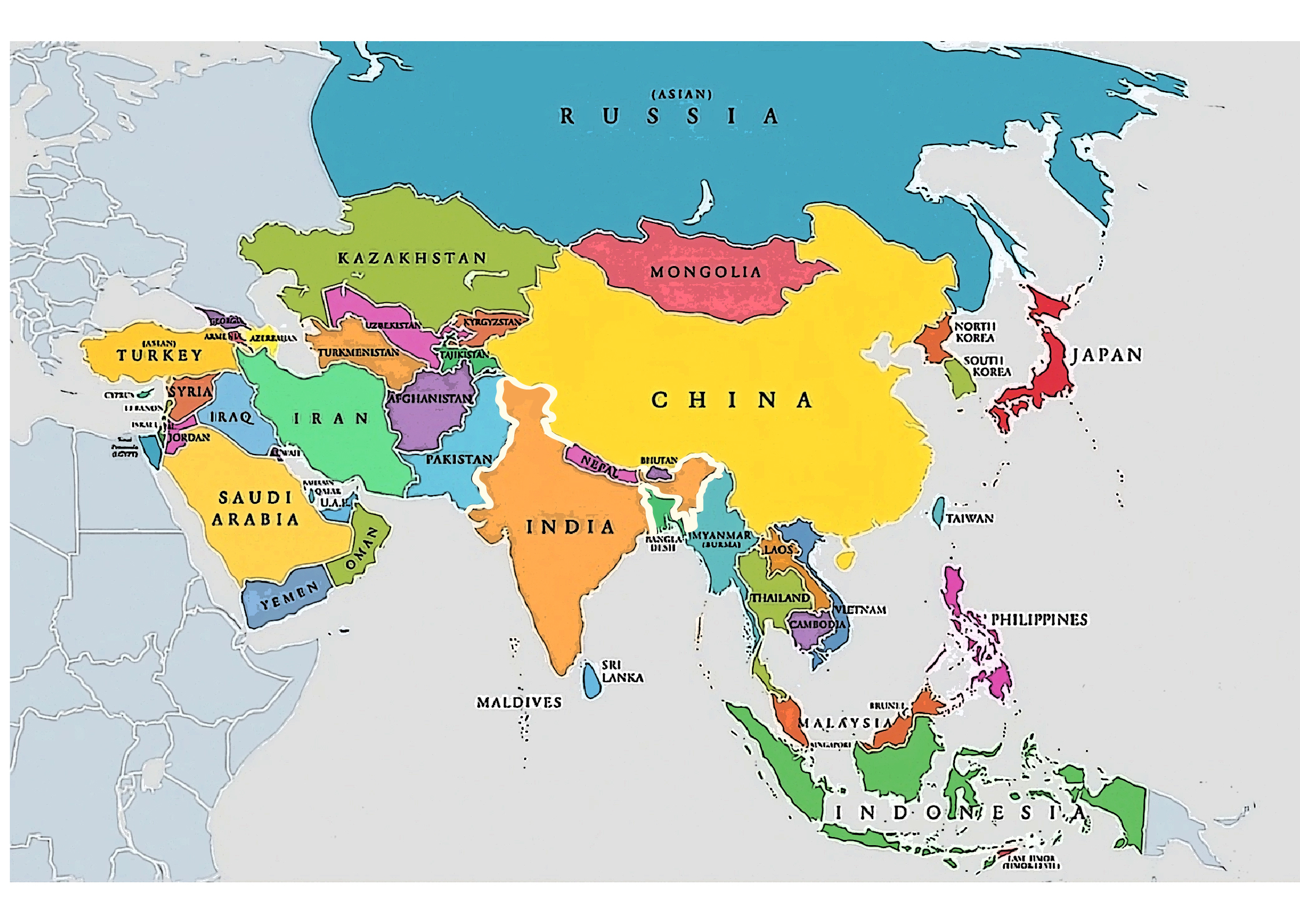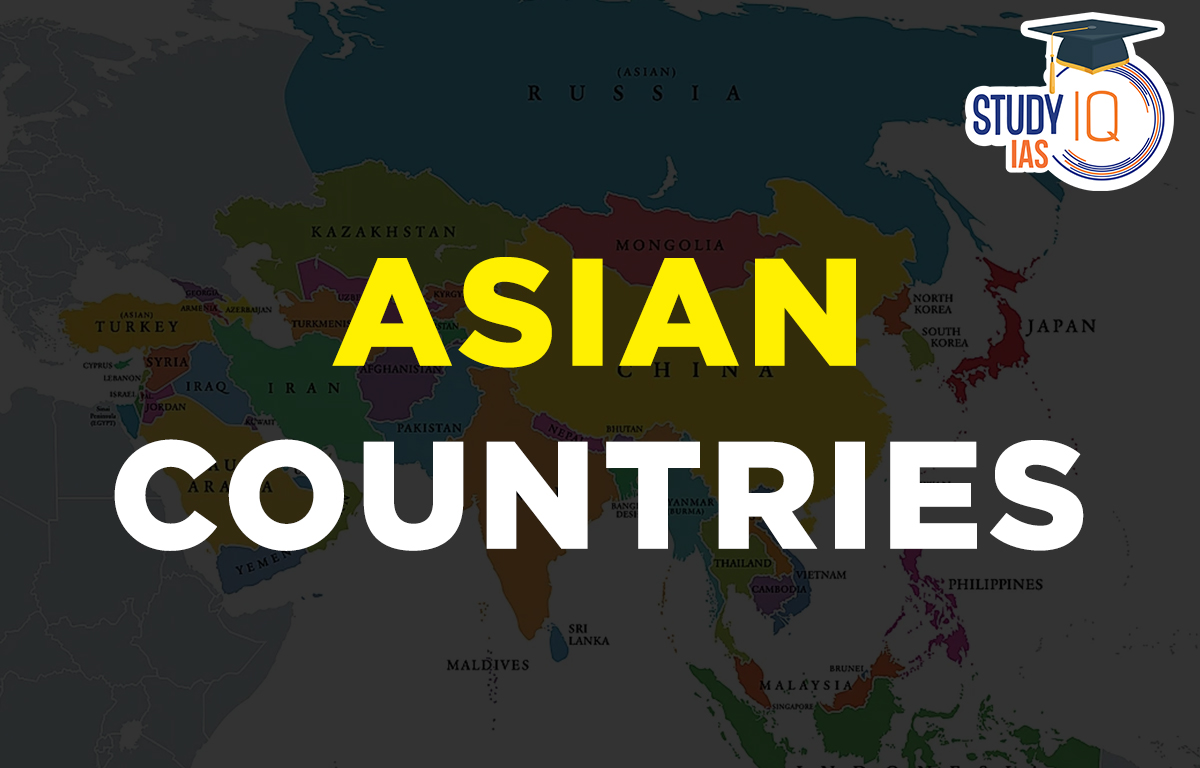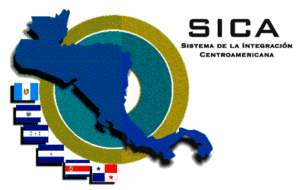Table of Contents
Asia, the largest continent on Earth, holds immense geographical, cultural, and economic significance. With 48 countries, Asia is home to over 60% of the world’s population. Its countries are spread across six distinct geographical regions, each with unique characteristics. Here’s a comprehensive guide on Asian countries, their capitals, regions, currencies, and populations.
Asian Countries List
Asia is spread over 44.58 million square kilometers and is bordered by the Pacific Ocean to the east, the Indian Ocean to the south, and Europe to the west. The continent is divided into five key regions:
- East Asia: China, Japan, Korea, and others
- South Asia: India, Pakistan, Bangladesh, etc.
- Southeast Asia: Indonesia, Philippines, Thailand, etc.
- Central Asia: Kazakhstan, Uzbekistan, Turkmenistan, etc.
- West Asia (Middle East): Saudi Arabia, UAE, Iran, etc.
Each region contributes significantly to the global economy, and many Asian countries are known for their ancient civilizations, technological advancements, and dynamic economies.
| Particulars | Details |
| Total Area | 49.7 million km² |
| Number of Countries in Asia | 50 (48 recognized by the UN) |
| Population in Asia | 4.561 billion |
| Number of languages spoken | Around 2,300 Languages |
| Biggest Country (area-wise) | China (9.6 million km²) |
| Smallest Country (area-wise) | Maldives (298 km2) |
| Most Populated Country | China (around 1.4 billion) |
| Highest Mountain in Asia | Mount Everest (8849 m) |
| Longest River in Asia | Yangtze River (Cháng Jiāng), China (3rd longest in World) |
How Many Countries Are in Asia?
According to the United Nations which covered around 49.7 million km² (19,189,277 square miles) i.e., about 30% of the total land area of the Earth. In the below table, there are 6 Physiographic divisions in India.
| Divisions | Countries |
| Central Asia | Kazakhstan, Kyrgyzstan, Tajikistan, Turkmenistan, Uzbekistan |
| Eastern Asia | China, Hong Kong, Japan, North Korea, South Korea, Macau, Mongolia, Taiwan |
| Northern Asia | Russia |
| South-eastern Asia | Brunei, Myanmar, Cambodia, Indonesia, Laos, Malaysia, Philippines, Singapore, Thailand, Timor-Leste, Vietnam. |
| Southern Asia | Afghanistan, Bangladesh, Bhutan, India, Maldives, Nepal, Pakistan, Sri Lanka. |
| Western Asia | Armenia, Azerbaijan, Bahrain, Cyprus, Georgia, Iran, Iraq, Israel, Jordan, Kuwait, Lebanon, Oman, State of Palestine, Qatar, Saudi Arabia, Syria, Turkey, United Arab Emirates, and Yemen. |
With more than 17 million km2, Russia is by far the largest nation in terms of area, with 13 million km2 (or 77% of its total area) located in Asia. With a total size of 9.6 million km2, China is the second-largest Asian country. The island country of Maldives, at 298 km2, is the smallest autonomous state in Asia. Check the important facts about the Asian Continent below in the table:
Asian Countries List and Capitals
Here are the complete 48 countries in Asia and their Capitals and Currencies:
| Country | Capital | Region | Currency | Population (2024 Estimate) |
|---|---|---|---|---|
| Afghanistan | Kabul | South Asia | Afghan Afghani (AFN) | 41.8 million |
| Armenia | Yerevan | West Asia | Armenian Dram (AMD) | 2.8 million |
| Azerbaijan | Baku | West Asia | Azerbaijani Manat (AZN) | 10.4 million |
| Bahrain | Manama | West Asia | Bahraini Dinar (BHD) | 1.8 million |
| Bangladesh | Dhaka | South Asia | Bangladeshi Taka (BDT) | 171.2 million |
| Bhutan | Thimphu | South Asia | Bhutanese Ngultrum (BTN) | 777,000 |
| Brunei | Bandar Seri Begawan | Southeast Asia | Brunei Dollar (BND) | 450,000 |
| Cambodia | Phnom Penh | Southeast Asia | Cambodian Riel (KHR) | 17.1 million |
| China | Beijing | East Asia | Chinese Yuan (CNY) | 1.41 billion |
| Cyprus | Nicosia | West Asia | Euro (EUR) | 1.2 million |
| Georgia | Tbilisi | West Asia | Georgian Lari (GEL) | 3.7 million |
| India | New Delhi | South Asia | Indian Rupee (INR) | 1.44 billion |
| Indonesia | Jakarta | Southeast Asia | Indonesian Rupiah (IDR) | 278.7 million |
| Iran | Tehran | West Asia | Iranian Rial (IRR) | 88.2 million |
| Iraq | Baghdad | West Asia | Iraqi Dinar (IQD) | 45.6 million |
| Israel | Jerusalem | West Asia | Israeli New Shekel (ILS) | 9.6 million |
| Japan | Tokyo | East Asia | Japanese Yen (JPY) | 124.7 million |
| Jordan | Amman | West Asia | Jordanian Dinar (JOD) | 11.4 million |
| Kazakhstan | Astana | Central Asia | Kazakhstani Tenge (KZT) | 19.7 million |
| Kuwait | Kuwait City | West Asia | Kuwaiti Dinar (KWD) | 4.5 million |
| Kyrgyzstan | Bishkek | Central Asia | Kyrgyzstani Som (KGS) | 6.9 million |
| Laos | Vientiane | Southeast Asia | Lao Kip (LAK) | 7.7 million |
| Lebanon | Beirut | West Asia | Lebanese Pound (LBP) | 6.5 million |
| Malaysia | Kuala Lumpur | Southeast Asia | Malaysian Ringgit (MYR) | 34.4 million |
| Maldives | Malé | South Asia | Maldivian Rufiyaa (MVR) | 557,000 |
| Mongolia | Ulaanbaatar | East Asia | Mongolian Tugrik (MNT) | 3.5 million |
| Myanmar | Naypyidaw | Southeast Asia | Burmese Kyat (MMK) | 55.5 million |
| Nepal | Kathmandu | South Asia | Nepalese Rupee (NPR) | 31.1 million |
| North Korea | Pyongyang | East Asia | North Korean Won (KPW) | 26.1 million |
| Oman | Muscat | West Asia | Omani Rial (OMR) | 5.4 million |
| Pakistan | Islamabad | South Asia | Pakistani Rupee (PKR) | 247.5 million |
| Palestine | Ramallah | West Asia | Israeli New Shekel (ILS) | 5.4 million |
| Philippines | Manila | Southeast Asia | Philippine Peso (PHP) | 119.9 million |
| Qatar | Doha | West Asia | Qatari Riyal (QAR) | 2.9 million |
| Russia* | Moscow | Eurasia | Russian Ruble (RUB) | 143.5 million |
| Saudi Arabia | Riyadh | West Asia | Saudi Riyal (SAR) | 36.5 million |
| Singapore | Singapore | Southeast Asia | Singapore Dollar (SGD) | 5.7 million |
| South Korea | Seoul | East Asia | South Korean Won (KRW) | 51.7 million |
| Sri Lanka | Sri Jayawardenepura Kotte | South Asia | Sri Lankan Rupee (LKR) | 21.4 million |
| Syria | Damascus | West Asia | Syrian Pound (SYP) | 19.8 million |
| Taiwan | Taipei | East Asia | New Taiwan Dollar (TWD) | 23.6 million |
| Tajikistan | Dushanbe | Central Asia | Tajikistani Somoni (TJS) | 10.1 million |
| Thailand | Bangkok | Southeast Asia | Thai Baht (THB) | 71.9 million |
| Timor-Leste | Dili | Southeast Asia | US Dollar (USD) | 1.4 million |
| Turkey* | Ankara | Eurasia | Turkish Lira (TRY) | 88.6 million |
| Turkmenistan | Ashgabat | Central Asia | Turkmenistan Manat (TMT) | 6.4 million |
| United Arab Emirates | Abu Dhabi | West Asia | UAE Dirham (AED) | 10.2 million |
| Uzbekistan | Tashkent | Central Asia | Uzbekistani Som (UZS) | 36.3 million |
| Vietnam | Hanoi | Southeast Asia | Vietnamese Dong (VND) | 103.7 million |
| Yemen | Sana’a | West Asia | Yemeni Rial (YER) | 34.3 million |
Asian Countries Map
Here is the location of Asian countries in the Map below.

The Northern Lowlands
The Northern Lowlands consist of vast plains found across Asia. Key lowland areas include:
- Great Siberian Plain: The largest lowland in the world, stretching about 1,200,000 square miles from the Lena River in the east to the Ural Mountains in the west.
- Manchurian Plain: Located in northern China, this plain borders the Amur River and spans roughly 135,000 square miles.
- Great Plain of China: Enriched by the Yangtze and Yellow Rivers, this plain covers over 158,000 square miles.
- Tigris-Euphrates Plains: This region, about 13,700 square miles, includes parts of Turkey, Syria, Iraq, and Iran.
- Ganga Plains: Known as the Indo-Gangetic plain, it stretches about 700,000 square kilometers in northern India, encompassing much of eastern and northern India, along with parts of Nepal, Pakistan, and Bangladesh.
- Irrawaddy Plains: An important part of the Great Asian Plains, located in Myanmar.
The Central Mountains
The Central Mountains are significant mountain ranges in Central Asia, including the Pamir and Tian Shan mountains. These ranges cover parts of China, Afghanistan, Kazakhstan, Kyrgyzstan, Tajikistan, and Uzbekistan and are classified as biodiversity hotspots. They feature various ecosystems like alpine tundra and temperate forests.
Asia has notable mountain knots where ranges intersect:
- Pamir Knot: Formed by the Himalayan, Hindu Kush, Kunlun, Karakoram, and Sulaiman ranges, it includes Mount Everest, the tallest mountain in the world.
- Armenian Knot: Connects to the Pamir Knot through the Elburz and Zagros ranges, with additional ranges like the Tien Shan and Altai.
Peaks of Asia
Some of Asia’s highest peaks include:
- Mount Everest (8,848 m) – Nepal-Tibet, China border
- K2 (8,611 m) – India-China
- Kangchenjunga (8,586 m) – Nepal-Sikkim, India
- Lhotse (8,516 m) – Nepal-Tibet, China
- Makalu (8,462 m) – Nepal-Tibet, China
- Cho Oyu (8,201 m) – Nepal
The Central and Southern Plateaus
Plateaus are elevated areas of land, often surrounded by deep canyons. They are significant geographic features in Asia.
| Plateaus | Location |
| Ladakh | Between Karakoram and Himalaya mountain ranges |
| Tibet | Between Kulun and the Himalayan Mountain range |
| Yunan | It is located southeast of the Tibet Plateau and divided from the vast, rich Szechuan Basin by a range of mountains |
| Pamir | Well connected to the range of mountains such as The Himalayas with the Tian Shan, Karakoram, Kunlun, and the Hindu Kush ranges on all sides |
| Armenian | Present in between the Caspian and the Black Sea |
| Iranian | Present in between Zagros Mountains, Caspian Sea, Turkmen-Khorasan Mountain Range |
| Mongolian | Encircled by the Alai Mountains to the west, the Yin Mountains to the south, the Sayan and Khentii Mountains to the north, and the Greater Hinggan Mountains to the east. |
| Shan | Stretched in the Pegu Yoma and Arkan Yoma in the eastern part of Myanmar, |
| Deccan | Stretched between the Indian Subcontinent’s Western and Eastern Ghats, it nearly reaches the country’s southernmost point and is sheltered in the north by the Vindhya and Satpura Ranges. |
| Anatolian | Bounded to the south by the Pontic mountain ranges and to the southwest by Taurus. |
Peninsula
A peninsula is a landmass connected to the mainland but surrounded by water. Southern Asia features major peninsulas, including Arabia, India, and Malay, while the Kamchatka Peninsula is located in northeastern Asia. The Deccan Plateau is also considered a peninsula.
Desert
Asia is home to several large deserts, such as the Gobi, Taklamakan, Thar, Kara-Kum, and Rub’ al-Khali. The Rub’ al-Khali, spanning Saudi Arabia, Oman, the UAE, and Yemen, is the largest sand desert in the world, covering an area larger than France.
Islands of Asia
Asia has many archipelagos, which are groups of islands located close together. Notable archipelagos include the Philippines, Indonesia, Japan, Andaman Islands, and Nicobar Islands.
Drainage of Asia
Asia is drained by vast seas, rivers, and lakes. Three major oceans surround the continent:
- Pacific Ocean: Includes rivers like the Mekong, Xi Jiang, and Huang Ho.
- Indian Ocean: Contains the Tigris, Euphrates, Indus, Ganga, and Brahmaputra rivers.
- Arctic Ocean: Features rivers like the Ob, Yenisey, and Lena.
Sea
Asia is bordered by many seas, including the Andaman Sea, Arabian Sea, Bering Sea, Caspian Sea, Sea of Japan, and South China Sea, contributing to its drainage.
Lakes
Major lakes in Asia include:
- China: Qinghai Lake, Lake Khanka
- India: Dal Lake, Chilika, Vembanada
- Indonesia: Lake Matano, Lake Toba
- Russia: Lake Baikal (the world’s deepest lake), Onega, Ladoga
- Japan: Lake Akan, Lake Biwa
Resources
In the north and central regions, especially Siberia, cold Arctic winds influence the climate. In the middle and southern areas, crops like barley, millet, and oats thrive despite frosts. Animal husbandry is significant in Mongolia, where cattle, sheep, and goats are raised on 75% of the agricultural land.
Asian Countries and Regions
In Asia, there are conventionally 6 main geographical regions or subregions:
- Northern Asia
- Western Asia
- Central Asia
- Eastern Asia
- Southern Asia
- Southeast Asia
Northern Asian Countries
The enormous east region of the Ural Mountains, commonly known as Siberia, is referred to as North Asia or Northern Asia. The area is separated among the Ural, Siberian, and Russian Far Eastern federal districts of Russia. The 13 million km2 (5.1 million sq mi) area is bordered to the north by the Arctic Ocean, to the west by European Russia, and to the east by the Bering Sea. Kazakhstan, Mongolia, and China border Siberia internationally from the south. In Northern Asia, 36 million people are estimated to reside (in 2020).
Western Asian Countries/ Middle East Countries
Western Asia is the term used to describe the western region of Asia, which encompasses the Arabian Peninsula and the majority of the Middle Eastern countries. Western Asia consists of 19 countries. All of these nations, except Armenia, Georgia, Israel, and the Republic of Cyprus, have a majority Muslim population. There are 279 million people in the area (in 2020). Here is the complete list of Western Asian Countries:
| Western Asian Countries/ Middle East Countries | |
| Name of Country | Population |
| Armenia | 2,963,243 |
| Azerbaijan | 10,139,177 |
| Bahrain | 1,701,575 |
| Cyprus | 1,207,359 |
| Georgia | 3,989,167 |
| Iran | 83,992,949 |
| Iraq | 40,222,493 |
| Israel | 8,655,535 |
| Jordan | 10,203,134 |
| Kuwait | 4,270,571 |
| Lebanon | 6,825,445 |
| Oman | 5,106,626 |
| Qatar | 2,881,053 |
| Saudi Arabia | 34,813,871 |
| State of Palestine | 5,101,414 |
| Syria | 17,500,658 |
| Turkey | 84,339,067 |
| United Arab Emirates | 9,890,402 |
| Yemen | 29,825,964 |
Central Asian Countries
The area of Asia between the Caspian Sea and Western China is referred to as Central Asia. All of the countries that constitute Central Asia — Kazakhstan, Kyrgyzstan, Tajikistan, Turkmenistan, and Uzbekistan are mostly Muslim nations. Central Asia is home to 74 million people, on average (in 2020). Here is the complete list of Central Asian Countries:
| Central Asian Countries | |
| Name of Country | Population |
| Kazakhstan | 18,776,707 |
| Kyrgyzstan | 6,524,195 |
| Tajikistan | 9,537,645 |
| Turkmenistan | 6,031,200 |
| Uzbekistan | 33,469,203 |
Eastern Asian Countries
East Asia, often known as Eastern Asia, is the term used to describe the eastern portion of the Asian continent as well as the island nation of Japan. The Republic of China (Taiwan), with a disputed political status, the Chinese Special Administrative Regions (SAR) of Hong Kong and Macao, and five sovereign nations are constituted in the Eastern Asian region. In Eastern Asia, 1.68 billion people are estimated in the region (in 2020). Here is the complete list of Eastern Asian Countries:
| Eastern Asian Countries | |
| Name of Country | Population |
| China | 1,439,323,776 |
| China, Hong Kong SAR | 7,496,981 |
| China, Macao SAR | 649,335 |
| Japan | 126,476,461 |
| North Korea | 25,778,816 |
| South Korea | 51,269,185 |
| Mongolia | 3,278,290 |
| Taiwan | 23,816,775 |
Southern Asian Countries
The southern region of central Asia is referred to as South Asia or Southern Asia. The Himalayas are located in the north, while the Indian Ocean forms its northern and southern borders. In the Southern Asia subregion, eight independent countries exist. South Asia is home to an estimated 1.94 billion people (in 2020). Here is the complete list of Southern Asian Countries:
| Name of Country | Population |
| Afghanistan | 38,928,346 |
| Bangladesh | 164,689,383 |
| Bhutan | 771,608 |
| India | 1,380,004,385 |
| Maldives | 540,544 |
| Nepal | 29,136,808 |
| Pakistan | 220,892,340 |
| Sri Lanka | 21,413,249 |
Southeast Asian Countries
Southeast Asia is the part of Asia that includes the Indo-Chinese Peninsula and the islands of Maritime Southeast Asia. It is located southeast of the continent, south of China, east of India, and north of Australia. As of 2020, about 668 million people live in Southeast Asia. Here’s the full list of countries in Southeast Asia:
| Name of Country | Population |
| Brunei Darussalam | 437,479 |
| Cambodia | 16,718,965 |
| Indonesia | 273,523,615 |
| Lao PDR | 7,275,560 |
| Malaysia | 32,365,999 |
| Myanmar (Burma) | 54,409,800 |
| Philippines | 109,581,078 |
| Singapore | 5,850,342 |
| Thailand | 69,799,978 |
| Timor-Leste (East Timor) | 1,318,445 |
| Vietnam | 97,338,579 |
Notable Features of Asian Countries
- Diverse Economies: Asia is home to some of the world’s largest economies, such as China, Japan, and India, along with rapidly developing countries like Vietnam and Bangladesh.
- Cultural Richness: Asia boasts ancient civilizations like China and India, and vibrant cultures in Southeast Asian nations like Thailand, Cambodia, and Indonesia.
- Population Giants: China and India together account for over a third of the global population, with each surpassing the billion mark.
Economic and Cultural Diversity in Asia
Asia’s economic landscape is highly varied. It contains some of the wealthiest nations (e.g., Japan, Singapore, South Korea) and developing nations working to enhance their economic standing. Cultural diversity is equally vast, with significant differences in language, traditions, religion, and societal structures across the continent.


 International Potato Center (CIP) in Agr...
International Potato Center (CIP) in Agr...
 Central American Integration System (SIC...
Central American Integration System (SIC...
 50 Years of Emergency: Samvidhaan Hatya ...
50 Years of Emergency: Samvidhaan Hatya ...





















